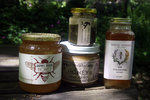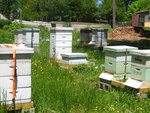Philadelphia has backyard gardens and open park space or lots across most neighborhoods, and relatively low use of pesticides, making it a relatively friendly habitat for honeybees.
This item is available in full to subscribers.
We have recently launched a new and improved website. To continue reading, you will need to either log into your subscriber account, or purchase a new subscription.
If you are a digital subscriber with an active subscription, then you already have an account here. Just reset your password if you've not yet logged in to your account on this new site.
If you are a current print subscriber, you can set up a free website account by clicking here.
Otherwise, click here to view your options for subscribing.
Please log in to continue |






It made national news last summer when Philadelphia Bee Company announced they had made a honey from secretions of the spotted lanternfly. While it might be too early to tell if this becomes a regional favorite or just a novelty, it drew attention to the popularity of locally produced Philadelphia honey.
Before the 20th century, it was common to keep bees. The Philadelphia Beekeepers Guild estimates they have over a hundred members throughout the region, with a high number in the Northwest. (They don’t keep an official count by geography.)
An apiary is one or more bee colonies, and each bee colony generally occupies a hive. The Guild maintains an apiary at Awbury Arboretum, where members can set up a hive if they can’t keep one at home (or in their apartment). They also host the annual Bee Festival at Wyck every September.
Philadelphia has backyard gardens and open park space or lots across most neighborhoods, and relatively low use of pesticides, making it a relatively friendly habitat for honeybees.
Ben Brown produces his honey in Chestnut Hill. Most of his bees are collecting pollen from his neighbors’ gardens or Pastorius Park. Brown’s Apiary is available at Weavers Way and Night Kitchen Bakery. You can return the jars for re-use, cutting costs and recycling waste.
Like most small urban producers, Brown’s honey would be classified as wildflower;. In order to specify a honey is flavored – blueberry, orange blossom – regulations require proof that at least 51% of the pollen came from those specific plants. Howe’s Honey in Wyndmoor can be more specific. On their Facebook page, they describe their honey as derived from “Linden tree flower nectar, a strain of honey which has the highest immune boosting and antioxidant properties.”
We Bee Brothers has more of a consumer presence, available in stores such as Weavers Way. A second-grade teacher at William Penn Charter School, Joel Eckel founded We Bee Brothers with his brother Jeff in 2007. They maintain hives throughout the Northwest, including the Wyck House and Blue Bell Horse Farm.
They harvest in late July. August can be too hot. Some beekeepers harvest more often; The Eckels used harvest in Spring and Fall, but they changed to avoid the heavier lanternfly honey in the Fall. “Lanternflies changed the landscape, with a strong nectar flow in the Fall,” said Jeff.
They also produce a line of Honey From Others, which bottles honey from other local beekeepers. “There’s lots of beekeepers in Philadelphia, but there’s really just a handful that are big enough to actually sell their honey,” said Joel.
Jeff Eckel also runs Instar Apiary, where he can try new ideas. He maintains hive at Rittenhousetown in the Wissahickon and the Stenton Museum, where he’s the caretaker. Instar is more of a supplier and, as Jeff puts it, “I want to play in the bee yard.”
The difference between raw and filtered honey comes down to how filtered the honey is, which comes down to heat; raw honey is not heated, so the filtering process is not as precise, and much of the pollen stays in. The heating process keeps the honey from crystalizing in the jar. The large commercial producers, said Joel Eckel, tend to use one pollen type and heat the honey more, filtering more of the pollen out, producing a weaker, more watery honey.
May is peak swarm season. The queen bee will fly out with half the workers, forming “a ball of bees” while some seek out a location for a new colony. By August the heat has slowed down the bees, but cooling autumn weather produces a new round of blossoms and a darker honey.
“It’s very much about what’s in bloom where you are,” said Jeff. Even if the same flowers are in two yards, the honey could be different, based on flower diversity and garden management.
What should consumers look for in honey? Jeff Eckel is also an Apiary Inspector for the PA Department of Agriculture, and recommended the first step is to check the wording on the label: “Does it says ‘produced by’ or does it say ‘bottled by’?” “Bottled” generally means re-packaged honey, and might be a mix of local and commercial, or even entirely commercial. “Somebody could just be buying buckets of honey, bottling it, and making it look like it’s local,” he explained.
Some of it involves getting to know the beekeeper, perhaps at a farmers market. “You should ask people how many hives they have.” Check their website: “Be skeptical if they don’t have pictures of their hives.”
Ask about survival. He mentioned “dead-outs,” hives where the bee colonies have died over the winter. Being completely “natural” and avoiding pest control isn’t necessarily ideal; in some cases, this means the colonies have died and been replaced frequently.
In general, he thinks most local producers are more interested in producing a quality product over making a profit. “I know a lot of beekeepers, and a lot of them do it right,” he said.
Instar also sells some USDA certified organic honey from Ukraine or Brazil. United States honey can’t be labeled organic because there isn’t a way to guarantee the pollen came from organic plants. Said Jeff Eckel, “If you go to the store and look for organic honey, most of it’s coming from Mexico, Brazil, the Ukraine.” The profit margin selling these imports is smaller, but he feels it’s worthwhile. “We’re bringing it in to expose people to different flavors.”
Lanternflies don’t start affecting the honey supply until late August, after they’ve been covering local backyard gardens for the summer.
Philadelphia Bee Company operates out of Kensington, which would not seem the most likely place, but Philadelphia has trees and open park space or lots across most neighborhoods, and relatively low use of pesticides, making it a friendly habitat for honeybees. Their lanternfly honey was a late edition, as they covered the area in late August. The honey product was not on purpose; when Don Shump, operator of Philadelphia Bee, noticed some of his honey had a darker color and “smokier” scent he sent it to Penn State University assistant research professor Robyn Underwood, a specialist in apiculture. Tests showed that the honey contained lanternfly DNA. Shump theorized the bees might have confused the “honeydew” left behind on trees by the lanternflies with tree sap.
The first time Christa Barfield met Jeff Eckel was at an Awbury Arboretum event where they both had vendor tables. He examined her Viva Leaf herb-infused honeys and told her they looked runny, possibly watered down. She assured them they were not. He assured her that he made honey, and what she was using wasn’t good enough for her botanicals. Some time later, Barfield dropped her wholesaler and was buying 60-gallon buckets of honey from Eckel’s Instar Apiaries.
“It was really cool of him to come over and basically call my honey trash,” she laughed.
For Viva Leaf, the infusion process can take time, depending on the flavor. “Our habañeros, the taste gets in there pretty quickly, so you don’t want to over-saturate that. But, like our tulsi [basil], you can keep that going for as long as you want.” She points out they can sometimes be complete without being added to something else. The lavender-infused honey, for instance, just add hot water and stir. “If you wanted a cup of lavender tea, that’s perfect for the whole thing.” They grow their own herbs, many in a greenhouse behind the store at 6730 Germantown Avenue. “Not only am I growing all the botanicals I’m infusing the honey with, but now I’m using honey that comes right from my neighborhood. How much better can it get?”